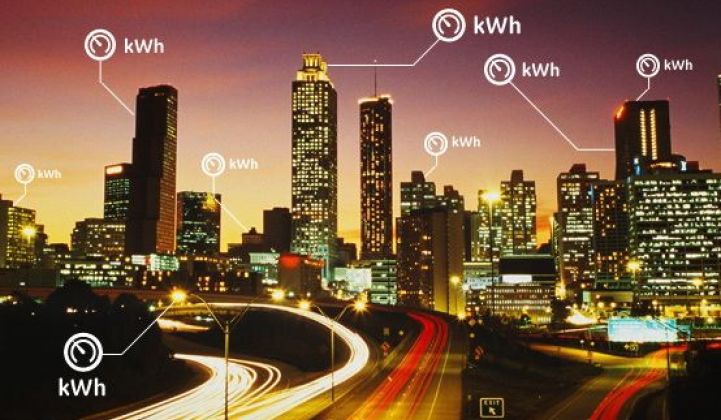General Electric has been slow to announce new customers for the smart-grid-as-a-service offering it launched in late 2011. But that doesn’t mean it’s not filling up its dance card with small municipal and rural cooperative utilities interested in a subscription-based smart grid -- or that the market for this kind of novel deployment may not be nearing an inflection point.
That’s one way of looking at the news that GE’s Grid IQ Solutions as a Service unit is close to maxing out the data center and IT asset capacity it built out over three years ago. Todd Jackson, Grid IQ Solutions product line leader, told me Wednesday that the SaaS platform is about 75 percent subscribed at present with some half-dozen customers. He expects it to be “oversubscribed” in the near future with more customer wins that are soon to be announced.
In the past three months, GE has named the municipal utilities of Holly Spring, Miss. and Skiatook, Okla. as customers, adding their names to those of flagship customers Norcross, Ga. and Leesburg, Fla. Three or four more customers are using the service, another three or four signed up in the fourth quarter of 2013, and an additional three are expected to sign up in the near future, he said.
Smart meters make up the first wave of deployments for these customers, who are paying GE a monthly subscription for a ten-year contract to install, manage and monitor those endpoints. For Holly Springs, GE has tapped grid networking vendor Trilliant, a long-time partner in projects from the U.S. to South America and the Philippines, to provide both neighborhood and wide-area mesh networks for electric, gas and water meters.
Other options include cellular communications, which Norcross is using, and GE’s point-to-multipoint solution with startup On-Ramp Wireless. UPDATE: GE is using Silver Spring Networks for its Leesburg AMI deployment, and in Norcross is tapping the household load control expertise of Consert, a startup bought by Toshiba's Landis+Gyr last year.
Beyond networking technologies, GE’s Grid IQ Connect platform offers a menu of options to choose from, including hosting of both data and applications for implementing meter data management (MDM) and network operations support on the back-end, and for customers, a choice of energy web portals and prepayment plans via partner PayGo.
In other words, it’s a hardware, network and software package, pre-integrated by GE, that should take the upfront cost, time to deployment, and complications of field-to-office integration out of customers’ hands, he said.
“To deploy a complete network as we do for water, gas and electric -- as you can imagine, it’s very expensive. When we offer [customers] that as a subscription fee, it softens the capital expense,” he said. On the software side, “Don’t undersell the integration piece -- we already have the pre-integrated solution via GE’s proprietary service bus,” with interoperability between the different portions of the system assured. Given the inevitable costs associated with bringing multiple vendor systems up and running, that’s a big deal for cash-strapped municipalities and electric co-ops.
But perhaps the most intriguing part of GE’s service offering is how it can serve as the platform for all kinds of smart grid systems to come. Right now, those come in two flavors, Jackson said. The first, Grid IQ Restore, adds outage detection and management options, built on the geographic information system GE has developed with Google Maps.
The second, Grid IQ Respond, brings demand response and load curtailment to the picture, as well as supply-side resources like distributed energy resources, he said. GE, like all of its big grid competitors, is striving to integrate new grid-edge assets like rooftop solar PV and fast-responding loads into a unified whole.
On GE’s side of the equation, the more customers it signs up, the more broadly it can distribute the costs of its upfront IT infrastructure investments. While Jackson didn’t disclose GE’s subscription pricing models or details about how many customers would be needed to turn the business profitable, “economy of scale does play into it,” he said.
The idea of capturing more small municipal and co-op utility business with a smart-grid-as-a-solution concept isn’t unique to GE. Iterations of the concept have been rolled out by contenders like Leidos (formerly SAIC), Silver Spring Networks and AT&T, and that’s not counting the even larger number of cloud-hosted grid software platforms, ranging from core utility operations like meter data management to still-nascent applications like data analytics.
But contenders that can make money and control costs on their side, while providing the right pricing, reliability and scalability for customers, could unlock a significant market. GTM Research has forecasted U.S. municipal utility smart grid spending at $4.5 billion to $9 billion from now until 2017, with a major part of that variability tied up in whether these utilities can surmount the barrier of high upfront costs to deploy.
Service models that work could help unlock those barriers -- and, of course, if they prove effective for the vanguard utilities trying them out, that could give more utilities the confidence to move forward, opening up what’s been a rather slow-to-develop business so far.
“We’re happy with the progress right now -- it’s moving at about the pace that we were expecting,” Jackson said. “Utilities are very deliberate in their decision-making. But there are quite a few requests for information and requests for proposals out on the street. […] I think you’ll see that it’s picking up pace.”



